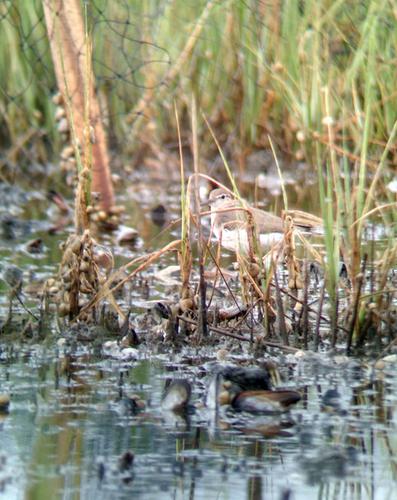Our official English website, www.x-mol.net, welcomes your feedback! (Note: you will need to create a separate account there.)
Predators enhance resilience of a saltmarsh foundation species to drought
Journal of Ecology ( IF 5.5 ) Pub Date : 2020-10-16 , DOI: 10.1111/1365-2745.13525 Sean J. Sharp 1 , Christine Angelini 1
中文翻译:

捕食者增强了盐沼基础物种的抗旱能力
更新日期:2020-10-16
Journal of Ecology ( IF 5.5 ) Pub Date : 2020-10-16 , DOI: 10.1111/1365-2745.13525 Sean J. Sharp 1 , Christine Angelini 1
Affiliation

|
- Disturbances are increasing in size and frequency with climate change, facilitating species that opportunistically exploit areas where habitat‐forming foundation species have been removed. Although it is well‐recognized that consumers, disease and weedy space‐holders can affect foundation species’ resistance to and recovery from disturbance, how predators influence their resilience is less clear.
- In salt marshareas de‐vegetated by drought and intensive snail Littoraria irrorata grazing (hereafter, ‘die‐offs’), we monitored bird use and experimentally manipulated bird and nekton access to the vegetated borders of die‐off mudflats across periods of both vegetation die‐off and regrowth to explore how these predators mediate the resilience of cordgrass Spartina alterniflora, the foundation species that structures US Atlantic coast salt marshes.
- Surveys revealed that birds, especially probers that agitate soils, forage year‐round for invertebrates in die‐off mudflats in our study area but not in adjacent vegetated areas.
- During periods of die‐off, cordgrass borders accessible to bird and nekton predators retreated >3‐times slower and snail densities were halved, relative to predator exclusion cages. In predator‐accessible plots, slower border retreat corresponded to greater snail infection by a bird host‐dependent trematode parasite. During recovery, cordgrass borders revegetated more quickly, and snail densities declined faster over time in unmanipulated controls relative to predator exclusions.
- Synthesis. These findings suggest that birds, through their transmission of parasites to snails, appear to act synergistically with snail‐consuming nekton to slow cordgrass loss after drought‐snail disturbances. Predator access also corresponds to faster cordgrass recovery as environmental conditions improve, although the mechanisms behind this need further investigation. Thus, predators that opportunistically forage within disturbances have the potential to suppress consumer impacts through multiple mechanisms, including consumption and disease transmission, thereby bolstering foundation species’ resilience and modulating whole ecosystem responses to climate change.
中文翻译:

捕食者增强了盐沼基础物种的抗旱能力
- 随着气候变化的干扰,干扰的规模和频率也在增加,这有利于那些机会性地利用那些已经消除了形成栖息地的基础物种的地区。尽管众所周知,消费者,疾病和杂草丛生的空间持有人会影响基础物种对干扰的抵抗力和从干扰中恢复的能力,但掠食者如何影响其复原力还不清楚。
- 在干旱和强烈的蜗牛利特托里亚草(Littoraria irrorata)导致植被消失的盐沼中,我们监测了鸟类的使用,并通过实验操纵了鸟类和尼克顿在这两个植被死亡期间进入死亡的泥滩植被边界的途径来回生长,探讨这些捕食者如何介导草草互花米草(Spartina alterniflora)(构成美国大西洋沿岸盐沼的基础物种)的弹性。
- 调查显示,鸟类(尤其是搅动土壤的探针)全年在我们研究区域的死灰泥中觅食无脊椎动物,而在相邻的植被区域中没有觅食。
- 在死亡期间,鸟类和尼克顿掠食者可接近的草丛边界的速度降低了3倍以上,并且蜗牛的密度相对于掠食者排斥笼子减少了一半。在掠食者可及的地块中,边界退缩速度较慢,对应于依赖宿主宿主的吸虫线虫寄生的蜗牛感染率更高。在恢复过程中,相对于掠食性动物的排斥,未操纵的草皮草的边界重新植被的速度更快,并且蜗牛密度随时间下降的更快。
- 综合。这些发现表明,鸟类通过将寄生虫传播给蜗牛,似乎与消耗蜗牛的尼古丁具有协同作用,从而减缓了干旱蜗牛干扰后的草丛损失。随着环境条件的改善,掠食者的进入也对应于更快的草草恢复,尽管其背后的机制需要进一步研究。因此,在干扰内进行机会性觅食的捕食者有可能通过多种机制(包括消费和疾病传播)抑制消费者的影响,从而增强基础物种的适应力并调节整个生态系统对气候变化的反应。



























 京公网安备 11010802027423号
京公网安备 11010802027423号